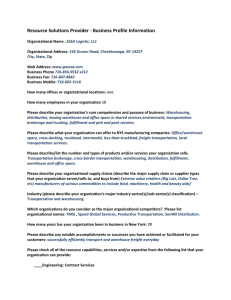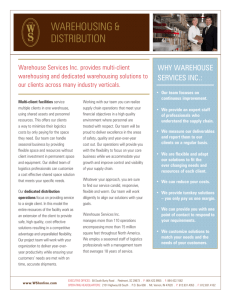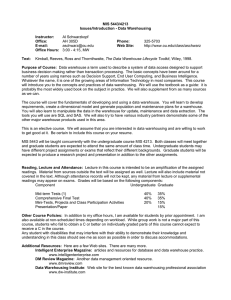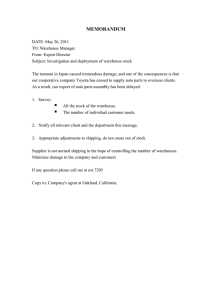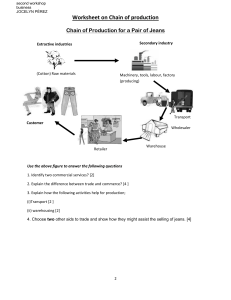Warehouse Management Systems: Data Warehousing Fundamentals
advertisement
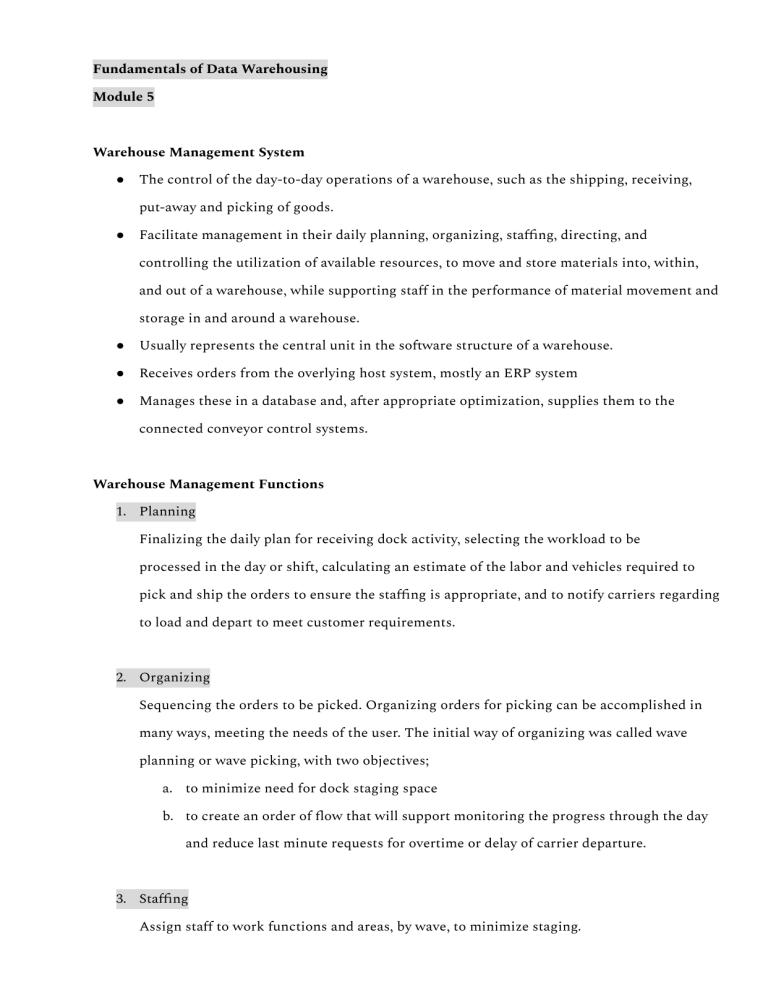
Fundamentals of Data Warehousing Module 5 Warehouse Management System ● The control of the day-to-day operations of a warehouse, such as the shipping, receiving, put-away and picking of goods. ● Facilitate management in their daily planning, organizing, staffing, directing, and controlling the utilization of available resources, to move and store materials into, within, and out of a warehouse, while supporting staff in the performance of material movement and storage in and around a warehouse. ● Usually represents the central unit in the software structure of a warehouse. ● Receives orders from the overlying host system, mostly an ERP system ● Manages these in a database and, after appropriate optimization, supplies them to the connected conveyor control systems. Warehouse Management Functions 1. Planning Finalizing the daily plan for receiving dock activity, selecting the workload to be processed in the day or shift, calculating an estimate of the labor and vehicles required to pick and ship the orders to ensure the staffing is appropriate, and to notify carriers regarding to load and depart to meet customer requirements. 2. Organizing Sequencing the orders to be picked. Organizing orders for picking can be accomplished in many ways, meeting the needs of the user. The initial way of organizing was called wave planning or wave picking, with two objectives; a. to minimize need for dock staging space b. to create an order of flow that will support monitoring the progress through the day and reduce last minute requests for overtime or delay of carrier departure. 3. Staffing Assign staff to work functions and areas, by wave, to minimize staging. 4. Directing Ensuring the documented processes and procedures are embedded in the WMS and are consistently applied, used and appropriate for the nature of the work and service level intentions of the company. 5. Controlling Providing milestones for management to monitor progress through the day, providing the opportunity to respond to problems in a timely way, and report data for performance analysis. Advantages of using a Warehouse Management System (WMS) A WMS will enable you to analyze current procedures and performance, and implement improvement that will: 1. Reduce picking errors Picking errors are costly at any stage of the process, if they are spotted before dispatch, there are the labor costs of re-picking. If incorrect items are shipped to the customer, not only is it expensive to accept the return and process the replacement, but there is the hidden cost of damage to the customer relationship. 2. Optimize stock control There must be a balance between having stock available for customers, and trying up too much capital. 3. Maximize use of space The right proportion of floor storage, vertical storage, racks and pallets for your warehouse will depend on the types of good stored and the patterns of distribution. 4. Improve worker productivity Your workforce is likely to be your biggest cost. How much would you save if you improved productivity? 5. Ensure compliance with Health and Safety regulations WMS can guide workers through risk assessments and flag up warehouse safety requirements, protecting your company, workers and customers alike. Dis-Advantages of Warehouse Management System (WMS): 1. Many processes are integrated into a system An error in one place entails errors in others. In this way, a human error can cause the whole system to be inaccurate. To prevent such situations, there are certain operations that the system will not allow you to perform (e.g. issuing more goods than what is available in the warehouse). 2. Risk of choosing incorrect parameters before use If the designed modules, categories, and processes are not well-tailored to your company, the system will gather data in an inefficient way. This may mean that your solution will not work as it was supposed to. To avoid this scenario, we ensure you get our support not only while we build the software but also during the implementation and post-implementation stages. 3. Granting unsuitable levels of authorization to employees within the system In the case of custom solutions, it is the client who decides which users will be able to view, edit, add, or delete data. Granting authorization to wrong people may prevent your processes from running smoothly. 4. Potentially unsuccessful implementation. Like every investment, also this one entails certain risk. To avoid unsuccessful implementation, it is important to make a detailed analysis of your needs, choose a competent software house, consult your project with your employees in terms of how the application should look like, as well as commit time to properly train your staff on how to use the application. Working with our clients, we pay attention to each of these elements so that you get a guarantee of the success of the project. Warehouse Value-Adding Roles Value-Adding Roles Trade-Off Areas Consolidation Transportation Product Mixing Order filling Service Lead times Contingency protection Stockouts Smooth operation Production Basic Warehouse Decisions: A Cost Trade-off Framework: 1. Ownership ● Public versus contract versus private 2. Centralized or Decentralized Warehousing ● How many ● Location ● Size ● Layout ● What products where The Ownership Decision: ● Public warehousing costs mostly all variable. ● Private warehousing costs have a higher fixed cost component. Thus, private warehousing virtually requires a high and constant volume. The Ownership Decision – factors to consider: ● Throughout volume ● Stability of demand ● Density of market area to be served ● Security and control needs ● Customer service needs ● Multiple use needs of the firm Public Warehousing 1. Rationale for Public Warehousing ● Limited capital investment ● Flexibility 2. Public Warehousing Services ● Bonded warehousing ● Field warehouse ● Public warehousing regulation: ● Liability ● Receipt 3. Public Warehousing Rates Based Upon: ● Value ● Fragility ● Potential damage to other goods ● Volume and regularity ● Weight density ● Services required Contract Warehousing ● Up 23% per year in 2000 to $20.4 billion. ● Compensation for seasonality in products. ● Increased geographical coverage. ● Ability to test new markets. ● Managerial expertise and dedicated resources. ● Less strain on the balance sheet. ● Possible reduction of transportation costs. The Number of Warehouses 1. Factors affecting the number of Warehouses ● Inventory costs ● Warehousing costs ● Transportation costs ● Cost of lost sales ● Maintenance of customer service levels ● Service small quantity buyers Fundamentals of Data Warehousing Module 6 Storage ● Storage and stores procedures are an integral part of any food and beverage control system. ● The purpose of efficient storage condition is to maintain materials or commodities in the condition in which they are purchased and for them to be safe until they are issued to the appropriate department for the use or sale to the customer. Store Room Requirements 1. Location The ideal location of a storeroom is near if not immediately adjacent to the receiving station and the kitchen. If not possible, then additional equipment and manpower would be required or alternative is use of conveyor belt for carrying the luggage. 2. Physical Properties ● Well Ventilated ● Not hot water and steam pipes ● No A.C Duct inside the store room ● No Drainage ● High temps play havoc with canned food ● Strict sanitation methods to be used to keep food free from vermin ● Shelving made of stainless steel with adjustable shelves depth- 18 inch. Items used frequently should be placed near the exit door. 3. Layout ● One door entry and exit ● Neat and clean moving are for staff and food items ● The size of the storeroom depends upon its location ● One counters issuing items ● No to unauthorized entry ● Door should have heavy secure locks and windows bared as a preventive measure against burglary. ● Liquor stores, wine cellars will need extra physical security systems due to high value of liquor stocks. ● Security Features ● Some large establishments used closed circuit television surveillance techniques for this purpose. 4. Equipments ● Large scale (weighing machine) ● Small scale ● Stout ladder ● Trolleys ● Cabinet ● Heavy work tables ● Ultraviolet rays lamp or sunlamps for helping in quick ripening of fruits and vegetables and aging of meat. 5. Storeroom Hours ● There should be locked Dutch doors ● One Shift or 24 hour operations ● All staff should be informed about the opening hours ● Emergency procedure must also exist for the issuing of stores ● Key Log Book ● There are generally two keys maintained are may be kept with the lobby manager during the night shifts. 6. Correct Storage Requirements of Commodities a. Meats ● All sides, quarters or whole carcasses of meat should be hung in cold room at a temperature of 0-1.c with a space between them to allow free circulation of air with drip trays placed underneath in order to collect any blood ( to avoid the formation of rigor mortis) ● According to the type of meat this period will vary from 2-10 days, permitting a chemical change to take place to produce more tender meat. b. Poultry and Game Poultry should be stored on slatted shelves at 0-1.c game placed on metal trays at the same temperature. c. Fish ● Wet fish should be stored in a separate, special type of refrigerator with perforated non- rust trays allowing the fish to drain and permitting easy cleaning of refrigerator. ● The fish should be placed on crushed ice on a wet cloth, covered with another cloth and crushed ice being stored at a temperature of 1c. d. Fresh Fruits and Vegetables ● All types of fresh fruits and vegetables need careful storage properly in a room where there is no sunlight. The room should be dry cool and well ventilated with bins for root vegetables. ● Fruits and vegetables deteriorate quickly and space should therefore be available to enable easy stock rotation. ● Soft fruits and melons should be refrigerated at 1-2.c. e. Dairy Products ● Most dairy products with the expectation of cheeses should be stored in a refrigerator or cold room at a temp of 0-4.c. ● Milk should be stored in a container in which it is delivered and kept covered because it will absorb strong smell. ● Butter and eggs also acquires smell of fish, onions and cheese. ● Cheese should be stored in a cool place which is dry and well ventilated. Because of its strong smell, cheese should be kept away from other items. If whole cheese is to be stored for a period of time, they should be rotated occasionally. f. Frozen Foods ● There is a great variety of frozen foods in either an uncooked or cooked state and these should be stored at a temperature of at least 15.c to 18c. ● Foods should be kept on plastic coated trays in upright deep freezers and in plastic type baskets in the chest type of deep freezer. g. Tinned Foods ● It should be stored in a dry, well- ventilated store to prevent them from rusting. ● Blown tins caused by gases should be discarded or returned to the supplier as oxidation has taken place of either bacteria or tin plating being attacked by the food. ● Dented tins should be used immediately before they rust. h. Dry Goods ● Sugar, flour pulses, preserved foods such as jams, pickles, dried fruits, tea, coffee. Conditions of storage for the same are dry, cool and well ventilated. ● They could be kept in bins with the lids on. Some dry goods require airtight lids such as tea and coffee. i. Cleaning Materials A separate store is necessary for all cleaning materials because of its strong smell and also possibility of confusion/mistakes being made. Stock Taking ● It is the process of physically counting all stock items in the store room, and kitchen. ● It is carried out by the F & B control department of the hotel. ● In the case of food stores, it is done once a month. ● Housekeeping item once in two months. ● Alcoholic beverage and Bar once in 24 hours. Purpose of Stock Taking ● To determine the value of goods held in stock ● To compare the value of goods actually in stores with the book value of the stock at the particular time ● To list slow moving items ● To compare usage with sales to assess food percentage as a deterrent against loss of pilferage ● To determine the rate of stock turnover Types of Stock Taking 1. Perpetual Stock Taking In this system, goods received or issued are immediately recorded on a stock taking sheet and compiled at the end of the day. In this system, at any given time you know the value of stock in hand. 2. Monthly Stock Taking The stock is calculated at the end of the month. Fundamentals of Data Warehousing Module 7 Warehouse Receiving Process ● The purpose of receiving is to ensure that the food and supplies delivered match the established quantity and quality specifications. ● The receiving personnel must have knowledge of food quality standard. ● The point at which food service operations inspect and take legal ownership and physical possession of the items ordered. 1. Unloading and checking the shipment: ● The number of containers or packages of materials unloaded from the carrier’s vehicle is checked against the carrier manifest. ● All containers or packages of materials are inspected for external damage. ● Failure to follow this procedure before accepting a shipment or delivery can relieve the carrier of all liability. 2. Unpacking and inspecting the material ● First, he or she checks the material received against the supplier’s packing slip and against a copy of the firm’s purchase order. ● Finally, the clerk reviews the condition of the material to determine whether there is external damage. 3. Completion of the receiving report ● The paperwork system used varies significantly from company to company. ● At Southwest Electric, the shipping clerks utilize a computerized purchasing/ inventory system. 4. Delivery of the material ● The receiving department is usually responsible for delivery of the material to the shop. ● Upon delivery of the materials, the supervisor customarily bills the material to the job, relieving the receiving clerk of further responsibility for the material. Fundamentals of Data Warehousing Module 8 Shipping Instructions 1. Instructions to suppliers, as integral parts of orders: ● Terms of purchase: FOB, CFR, CIP (specify the port/ airport) ● Method of dispatch: ocean freight, airfreight, container. ● Packing required, shipping marks and addresses ● Name of forwarded to contact, if applicable 2. Instructions to forwarders or suppliers as such: ● Documents required, how many copies (recommend 3 original B/L, for example) ● To whom documents must be distributed ● Transportation charges payable by the buyer 3. Information on recommended routing: The decision on routing should not be left to chance, but be taken by the buyer, often with feedback and advice from the freight forwarder and/or from the receiving end. 4. Instructions or information on insurance coverage: Instructions should specify either that coverage is not required the consignment will not be commercially insured, or will be insured by the agency or that insurance arrangements are to be made, and in that case, specify the risks to be covered. 5. When in doubt on the method of dispatch: For many orders there is no doubt about the method of dispatch, for example due to the size, weight or urgency, they are scheduled for surface or air and sent accordingly. There are frequent cases, however, when it is not known at the time of placing the order whether surface or air should be selected. Considering the high cost of transit and on-forwarding charges. International Trade and Transport Documents 1. Air waybill 2. Truck bill of lading 3. CMR transport document 4. Bill of Lading 5. Air waybill AWB 6. International commercial invoice 7. Proforma invoice 8. Packing list 9. Delivery note 10. Certificate of origin 11. The shipper’s letter of insurance Types of shipping containers Be resistant: ● To withstand ● Shipment ● Storage ● Handling Container Service Types 1. Full Container Load (FCL) This is when the full container is used by a single customer for his cargo. 2. Less than Container Load This is when the same container is used for cargoes belonging to multiple shippers and consignees. Types of Shipping Documents 1. Bill of lading The BOL is a contract between the owner of the goods and the carrier. 2. Commercial Invoice The invoice is the bill for the goods from the seller to the buyer. It can be used to determine the true value of goods when assessing the amount of customs duty. 3. Certificate of Origin The COO is a signed statement which identifies the origin of the export item. 4. Inspection Certificate This document may be required by the customer to certify the goods have been inspected or tested and the quality of the goods is acceptable. 5. Export License This license is a government document that authorizes the export of goods in specific quantities to a specific destination. 6. Shipper’s Export Declaration The SED is used for export statistics. 7. Export packing list This is a detailed packing list that itemizes each item in the shipment.
